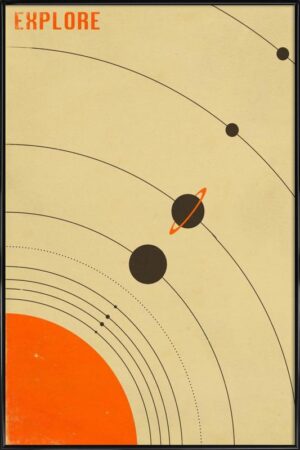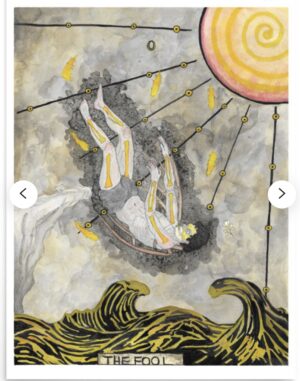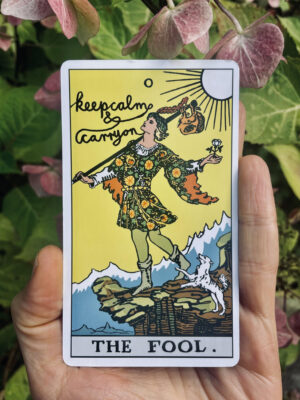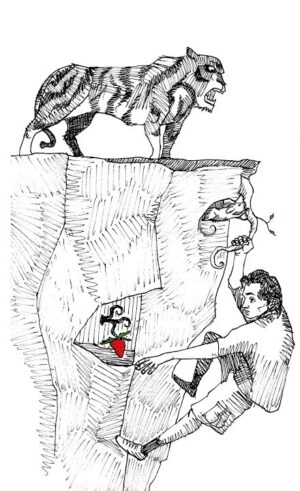
In the autumn of 1918, a seven movement orchestral suite written over a period of four years by the English composer Gustav
Holst, premiered at the Queen’s Hall in London. Holst’s The Planets is arranged, like Tarot as a journey of sorts, a musical arcana: beginning with Mars, The Bringer of War and ending with Neptune, The Mystic. Having spanned the first world war in its writing, Holst might be seen as channeling the collective unconscious in his music. The Planets was described at the time as “the most ferocious piece of music in existence”; its rhythms, played at a tempo much quicker than a march, with little ingress given to deeds of heroism and patriotism. Rather, Mars, Bringer of War foreshadowed the inhuman mechanical forces threatening to overturn the fragile balance of our animal human peaceful co-existence, “lurching forward relentless and unstoppable” (Short, 1990:123). John Williams took many elements of Holst’s Mars for his Imperial March composition which you may recognise from the soundtrack he wrote for Star Wars’, establishing that dark, shadowy, brooding palette for each appearance of Darth Vader and his Death Squadron.
Holst’s music was boundary-pushing in many ways, not least the manner in which it was brought to a close via a fade-out. This had never been done before in classical music, and certainly not in this way. The fade-out, which occurs at the end of the last movement (Neptune, The Mystic) involves a Female Chorus who join the orchestra in this manner from a description in the score:
“The chorus is to be placed in an adjoining room, the door of which is to be left open until the last bar of the piece, when it is to be slowly and silently closed. This bar to is be repeated until the sound is lost in the distance.”
Presumably, such was the era, that it was not thought possible that female singers might be able to handle a fade-out using the gradual lowering of their own voices. Or maybe it was a veiled commentary on how The Male Powers That Be shut off and shut out the more peaceful energies associated with female archetypes: the maiden, the mother, the mystic.
Perhaps this is not surprising if you consider that this was also a period where women in Britain were demanding equal rights from their male politicians, husbands, fathers and brothers. In the early 20th century until the outbreak of World War I, when Holst starting writing The Planet’s, approximately one thousand suffragettes were imprisoned in Britain, and some like Emily Davison lost their lives in the process of fighting for their right to vote, for equality and enfranchisement in domestic and work setttings.
Ironically the first fade-out in recorded popular music also involves doors in its set-up. “Open The Door Richard” was recorded by Dusty Fletcher in 1946 and begins its fade-out about five seconds before the end of this brief, 3 minute song.
Open The Door Richard was based on a vaudeville routine (well worth watching on YouTube) in which Fletcher plays a drunken or stoned fool (I’m high as a Georgia Pine, but there ain’t no use being too high though) attempting to get back into the living quarters he shares with a friend or maybe his partner, Richard. The knockabout comedy of the scene involves Fletcher drunkenly climbing and falling off a workmen’s ladder as he attempts to break into his own boarding house. The short film has the feel of an African-American waiting for Godot, twenty years before Beckett introduced us to his two Irish fools, albeit with Russian names, Estragon and Vladimir, and their lost, yearning absurdist plight.
ESTRAGON: Charming spot. (He turns, advances to front, halts facing auditorium.) Inspiring prospects. (He turns to Vladimir.) Let’s go.
VLADIMIR: We can’t.
ESTRAGON: Why not?
VLADIMIR: We’re waiting for Godot.
ESTRAGON: (despairingly). Ah! (Pause.) You’re sure it was here?
VLADIMIR: What?
ESTRAGON: That we were to wait.
VLADIMIR: He said by the tree. (They look at the tree.) Do you see any others?
ESTRAGON: What is it?
VLADIMIR: I don’t know. A willow.
ESTRAGON: Where are the leaves?
VLADIMIR: It must be dead.
ESTRAGON: No more weeping.
VLADIMIR: Or perhaps it’s not the season.
ESTRAGON: Looks to me more like a bush.
VLADIMIR: A shrub.
ESTRAGON: A bush.
VLADIMIR: A—. What are you insinuating? That we’ve come to the wrong place?
ESTRAGON: He should be here.
VLADIMIR: He didn’t say for sure he’d come.
ESTRAGON: And if he doesn’t come?
VLADIMIR: We’ll come back tomorrow.
ESTRAGON: And then the day after tomorrow.
VLADIMIR: Possibly.
 What you might ask has any of this to do with the Tarot fool. Well, at a very simple level: gravity. We are creatures whose minds and bodies work according to gravitational forces. What goes up…scratch must come down. What fades in, must fade out. Or sometimes just stop. In music production, this sudden ending, the equivalent of an orgasm or a heart attack, is called a Cold End. Most classical and early popular music would end in this way (examples). But as soon as we had the technology to create fade-ins and fade-outs, it seems like we often preferred this ending to falling off the edge of a track like that cartoon coyote Wile E. Coyote, the roadrunner’s nemesis, plummeting to their potential death again and again. Listen to how this song which I used in my last episode comes to a cold-ends in its recorded version. And here’s my fade-out on the last chorus, trying to build into that sonic tapering off a sense of us closing the door, but not entirely, on this joyous musical and non-musical tomfoolery which we hope will continue for those involved long after we have exited or left them behind. The fade-out in this case I hope hints at continuity and the perpetuity of life’s riches, even when we are no longer there in body or ears to appreciate this. Perhaps another analogy is that of walking down a gentle, rolling hill after a long hike, walking back into the village where you started from, the body gratified by all it has seen and explored, and looking forward to a pint of Guinness and a packet of peanuts before taking the train home.
What you might ask has any of this to do with the Tarot fool. Well, at a very simple level: gravity. We are creatures whose minds and bodies work according to gravitational forces. What goes up…scratch must come down. What fades in, must fade out. Or sometimes just stop. In music production, this sudden ending, the equivalent of an orgasm or a heart attack, is called a Cold End. Most classical and early popular music would end in this way (examples). But as soon as we had the technology to create fade-ins and fade-outs, it seems like we often preferred this ending to falling off the edge of a track like that cartoon coyote Wile E. Coyote, the roadrunner’s nemesis, plummeting to their potential death again and again. Listen to how this song which I used in my last episode comes to a cold-ends in its recorded version. And here’s my fade-out on the last chorus, trying to build into that sonic tapering off a sense of us closing the door, but not entirely, on this joyous musical and non-musical tomfoolery which we hope will continue for those involved long after we have exited or left them behind. The fade-out in this case I hope hints at continuity and the perpetuity of life’s riches, even when we are no longer there in body or ears to appreciate this. Perhaps another analogy is that of walking down a gentle, rolling hill after a long hike, walking back into the village where you started from, the body gratified by all it has seen and explored, and looking forward to a pint of Guinness and a packet of peanuts before taking the train home.
David Huron, who runs the School of Music and Center for Cognitive and Brain Sciences at Ohio State University, takes us into the metaphysical realms of gravity as it applies to music in his book Sweet Anticipation: Music and the Psychology of Expectation. “With a fade-out,” he writes, “music manages to delay closure indefinitely.The ‘stop’ gesture is replaced by a gesture towards the ‘infinite.’ ”
A few years ago, some researchers at Hanover University had music students tap along to the beat of different versions of the same song. One song ended with a fade-out, another brought things to a halt with an exuberant flourish. Listening to the cold ending, people stopped tapping an average of 1.4 seconds before the music itself came to an end. Sensing the auditory precipice about to pull us into nullity, it is as if we almost give up on the song we’re currently listening to, on the life of the song, as well as giving up on our own pleasure before the piece is even over. As we sometimes hardly taste the food on our plate when finishing it off, we perhaps cheat ourselves out of potential experience, but is that not always the case. When listening to a fade-out however, the music students continued tapping a couple of seconds after the song’s end, supporting the idea that the fade-out allows the song to live on beyond its physical limits, as we human animals have always hoped the soul might do when biological functioning comes to its own cold-end. And even though we all apprehend that fundamental law of existence which states that everything, including us, lives in the dimension of transience, that no experience or situtation can endure permanently in a system predicated on entropy, metamorphosis and change, the idea, the fantasy of a neverending story is still a sweet one – in all sorts of domains, especially that of eros and ambition. I guess it also belies that romantic but also death-loving notion that it’s better to burn out than to die away, a phrase introduced to us in a Neil Young song from the 70s, but further glorified in Kurt Cobain’s suicide note. Like really, Kurt? I think Dave Grohl has shown us all that it’s probably better to fade away, note to self.
This feels a little counterintuitive, for surely it might be expected to leave us frustrated, this denial of a final resounding chord, bringing everything to a conclusive end. “But because the fade-out has a slow, gradual trajectory, writes Phillip Ball in his book The Music Instinct, “we can anticipate its vanishing point rather as we can anticipate the resting place of a rolling ball, and so we have a kind of substitute expectation that is fulfilled, leaving us with a mixed emotion that might be described as contented yearning.”
Perhaps this phrase “contented yearning” is a truer approximation of what we sometimes refer to with words like happiness or fulfilment. I think here of Freud’s famous distinction in his Studies on Hysteria (1895) between neurotic dysfunctionality and ordinary human suffering: “that much will be gained if we succeed in transforming our hysterical misery into common unhappiness”. The latter notion (common unhappiness) perhaps closer to this idea of a fade-out, or a more gentle fall than the ups and downs of “hysterical misery”. Is not the the chorus, where the fade often occurs, not the most pleasurable, even addictive part of the song (filled as it is with all those melodic hooks) even as we hear it slide into abeyance. And is not the displeasure of this abeyance, this departure, this hedonic recession also a kind of bittersweet but meaningful farewell.
 “The person who will not suffer pain fails to ‘suffer’ pleasure” writes the psychoanalyst Wilfred Bion in his book Attention and Interpretation (1970). This denies us, he goes onto explain, the encouragement we might otherwise receive from accidental or intrinsic relief.” We seem inclined at times to cold-end our emotions or perceptions, rather than staying with them for the fade-out, the fall, however that occurs for us.
“The person who will not suffer pain fails to ‘suffer’ pleasure” writes the psychoanalyst Wilfred Bion in his book Attention and Interpretation (1970). This denies us, he goes onto explain, the encouragement we might otherwise receive from accidental or intrinsic relief.” We seem inclined at times to cold-end our emotions or perceptions, rather than staying with them for the fade-out, the fall, however that occurs for us.
Fall. Fool. Even linguistically, the word fool seems just a short phonemic step or slide away from a nosedive, or is it a kind of take-off, (/fɔ:l/ => /fuːl/). Which comes first, the fall or the fool? Phonologically speaking, fool seems higher placed in the mouth than fall, like a phoenix emerging from the flames of suffering. Perhaps one can only be a fool if one has fallen many many times over one’s life and found, after being knocked down once more, a way to get up again.
And what of that modernist icon, the flower-proferring Fool as imagined by Patrician Coleman Smith for what is now considered by many to be our archetypal tarot deck, the Rider-Waite-Smith pack of 1909. This non-binary fool as I see them, is wearing a kind psychedelic frock that wouldn’t look out of place in Grayson Perry’s bright, even gaudy, trans wardrobe. They are frolicking through an alpine landscape with thir little dog (shades of Heidi or Tintin) carrying all their worldly goods in knapsack tied to a stick, which we also recognise as a repurposed wand.
I find it interesting that this image was created in the first decade of the last century where the world began to feel that it it might too fall disasterously into global war and chaos, which of course it did, and is set to do again no doubt with pandemics and climate catastrophes threatening our continuation as a species. Just in case you haven’t been keeping up with what’s going on out there: humanity is currently in the midst of a fade-out.
Recently a University in the UK asked 10,000 16-25 year olds what they thought our odds might be in terms of surviving the catastrophes we unwittingly, foolishly, oh what fools we are, brought upon ourselves. Eighty-three percent of the respondents believe that we haven’t taken adequate care of our planet. Three quarters of them see the future as frightening, and more than half believe that we are doomed as a species, doomed to extinction. And yet, of course, like everyone who agrees with them (I certainly do), the option now of cutting back on our hypercapitalist, consumer-driven lifestyle, a way of being in the world that we’ve all grown accustomed to, maintained by fossil fuels and non-recyclables, suggest that there really is no turning back now. Is it not plain for all to see, that this foolish, greedy, comfort-seeking animal species, is on the verge, if not already going over the edge, maybe even quite soon, perhaps even by the end of this century, as we continue stare fixedly into the sky, waiting for the great gods of Science and geopolitical collaboration to save us. I think it’s also pretty clear by now that the cavalry ain’t coming. Perhaps this generation and certainly future ones will experience some kind of painful asphyxiating fade-out rather than the here-today-gone-tomorrow cold-ends that we feared from nuclear war in the 20th century, or terrorism. Had covid been ten percent more transmissable (as future plagues are quite likely to be), our species would have been decimated in no time at all.
“What bulk can we ascribe to thoughts?” asks Jung in his collection of talks published as Man’s Search For A Soul: “Are they small, large, long, thin, heavy, fluid, straight, circular, or what? If we wished to form a vivid picture of a nonspatial being of the fourth dimension, we should do well to take thought, as a being, for our model.” Is not the fool, some version of a thought, a psychic phenomena acting with the world. And what is that world, that landscape. Jung goes on to delineate this landscape, its hills and valleys and mountains, as the unconscious, which he distinguishes from conscious experience thus:
“While consciousness is intensive and concentrated, it is transient and is directed upon the immediate present and the immediate field of attention; moreover, it has access only to material that represents one individual’s experience stretching over a few decades. A wider range of “memory” is artificially acquired and consists mostly of printed paper. But matters stand very differently with the unconscious. It is not concentrated and intensive, but shades off into obscurity; it is highly extensive and can juxtapose the most heterogeneous elements in the most paradoxical way. More than this, it contains, besides an indeterminable number of subliminal perceptions, an immense fund of accumulated inheritance-factors left by one generation of men after another, whose mere existence marks a step in the differentiation of the species.
He then goes on to personify this collective human being, a non-binary creature “combining the characteristics of both sexes, transcending youth and age, birth and death, and, from having at [their] command a human experience of one or two million years, almost immortal. If such a being existed,” which of course they do, as an archetype, that of the fool, I would argue, “[they] would be exalted above all temporal change; the present would mean neither more nor less to [them] than any year in the one hundredth century before Christ; [they] would be a dreamer of age-old dreams and, owing to [their] immeasurable experience, [they] would be an incomparable prognosticator. [They] would have lived countless times over the life of the individual, of the family, tribe and people, and [they] would possess the living sense of the rhythm of growth, flowering and decay.”
And this creature, who of course is all of us, connects with their landscape, their surroundings (the collective unconscious, which also lives through and in each of us) via a kind of creative engagement with our world that we sometimes call play, and at other times, dream:
“This being dreams. At least it seems to us as if the collective unconscious, which appears to us in dreams, had no consciousness of its own contents—though of course we cannot be sure of this, any more than we are in the case of insects. The collective unconscious, moreover, seems not to be a person, but thing like an unceasing stream or perhaps an ocean of images and figures which drift into consciousness in our dreams or in abnormal states of mind.”
When “awake” though this creature, our fool, lives wholly/holy in the Now, focused on the present and on presence, as if a slip of attention, might lead to a precipitous fall into the unconscious, primitive, animality of fight and flight:
Here is a human animal who “stands upon a peak, or at the very edge of the world, the abyss of the future before them, above them the heavens, and below the the whole of so-called mankind with a history that disappears in primeval mists.”
This creature is ““unhistorical” in the deepest sense and has estranged himself from the mass of men who live entirely within the bounds of tradition. Indeed, he is completely modern only when he has come to the very edge of the world, leaving behind him all that has been discarded and outgrown, and acknowledging that he stands before a void out of which all things may grow.
 There is a zen parable that I have always loved. It relates to an incident of someone caught between two potential forces of annihilation. Maybe at a more metaphorical level you too might have experienced times when you felt yourself caught between a rock and a hard place, when the thought “Well I’m just screwed here, aren’t I?” confirms some crippling loss of agency for the self. Here is the parable rendered as a pithy poem by Chio Nakamura:
There is a zen parable that I have always loved. It relates to an incident of someone caught between two potential forces of annihilation. Maybe at a more metaphorical level you too might have experienced times when you felt yourself caught between a rock and a hard place, when the thought “Well I’m just screwed here, aren’t I?” confirms some crippling loss of agency for the self. Here is the parable rendered as a pithy poem by Chio Nakamura:
WILD STRAWBERRIES
You’re having a bad day.
Chased by a tiger to the edge of a cliff,
you scramble over and grab hold of a vine.
But now there’s another one prowling below,
and two hungry mice heading for your lifeline.
You take a deep breath,
adjusting to how things are,
and notice some wild strawberries
growing nearby,
dotted with flowers
and tiny red fruit.
What else can you do now but reach for a berry?
What else can you do now?
Keep. Calm. And. Carry. On.
You may be aware of the story behind this resuscitated 1940s meme. How the British Ministry of Information came up with the stiff-upper-lip mantra, to orchestrate and strengthen public morale with the threat of war looming. You may have heard how the two and a half million posters never fully connected to the public imagination as [devotional?] images until one of these pieces of mild-mannered propaganda was hung up near the cash register of a second-hand bookshop in Northumberland, attracting enough interest to spur on a merchandising empire. Twenty years later, aided by the internet, replicas of the poster are now on sale from Barter Books in Alnwick, Northumberland, but everywhere else too, printed onto a deluge of mugs, t-shirts, keyrings, vegan fruit flavour jelly sweets, stress balls, golf-balls, cushions, tote bags, and that’s only the first page of Amazon merch you can buy with this phrase stamped onto it. Eight-hundred and fourteen other options are also available for those keen to be reminded to kcaco on a daily basis.
I have always been somewhat repulsed by the injunction which has sounded in my ears as a sanctimonious piece of stiff-upper-lippery, intertwined with our fetishisation of royalty: each iteration of the epigram capped by the supposedly fortifying image of a Tudor Crown. As if Royal poise and composure so familiar to us from media images of that archetype extending a polite gloved hand to the hoi-poloi kneeling and fawning in grateful admiration before them, were a matter of personal virtue rather than a performance of priveleged exemption from most of the travails of life by dint of wealth and power.
 A few months ago however, I saw a Keep Calm & Carry On Tree-shaped air-freshener hanging from the rear-view mirror of a beaten up Rover Mini Cooper and had my own mini awakening. For it struck me that this twofold injunction to self-regulate in moments of high stress (keep calm) plus a behavioural cue to bring one’s focus and energies to a meaningful task (and carry on), was as good an operating system for our current iteration of human animality as anything else.
A few months ago however, I saw a Keep Calm & Carry On Tree-shaped air-freshener hanging from the rear-view mirror of a beaten up Rover Mini Cooper and had my own mini awakening. For it struck me that this twofold injunction to self-regulate in moments of high stress (keep calm) plus a behavioural cue to bring one’s focus and energies to a meaningful task (and carry on), was as good an operating system for our current iteration of human animality as anything else.
It is also intrinsic to the wisdom of the fool who might see the winding spiritual paths that some feel inclined to climb, always promising to deliver us from our “lower”, instinctual nature to that of a “higher” spiritual essence as a false distinction, a form of spiritual materialism or spiritual bypassing, which is to say, “the tendency to use spiritual ideas and practices to sidestep or avoid facing unresolved emotional issues, psychological wounds, and unfinished developmental tasks” in the words of John Welwood.
Spiritual materialism, like any form of non-spiritual materialism, sees peace or the serenity of enlightenment as something to be found at some point in the future through undertaking a hero’s journey of asceticism, meditation, and study rather than a here-and-now self-transcendence where peace and calm are sought and maybe even created for our minds in any moment rather than as a hoped-for spiritual end product.
“This [end-product] can only be and remain a dream, a fantasy,” writes the spiritual teacher and artist Lee Lozowick, “the pot of gold at the long end of the large and elusive rainbow…which is basically physically impossible.” What is possible however is to breathe in deeply, and then on the outbreath surrender completely to our conscious experience in every moment. Or perhaps to focus with curiosity and wonder on a wild flower or piece of fruit by the side of the road, or the one clasped in our hand, as in the Rider-Waite image of the Fool, even if this focus might result in a moment of looking away from our potentially threatening surroundings so as to experience a few seconds of peace from within. What else can we do now but reach for a berry?
But what if that continual reaching for the berry, for our phones, and all the other aspects of our life that require electricity, oil, coal, gas to power them?
We don’t like to fall, to fail, to be a fool (especially in the eyes of a another if it also involves some diminishment in status) and will do everything we can to avoid feeling this way even though we also understand as soon as we move from a crawling position and attempt to stand and walk, as we all do as infants, that falling, failing, and being foolish is hardwired into us and how we see ourselves and the world.
It’s certainly core to our language. Lakoff and Johnson in their book Metaphors We Live By show how the psyche is structured according to certain orientational metaphors which are mainly to do with, being creatures who work in three dimensions, up-down, in-out, front-back, on-off, deep-shallow as well as central versus peripheral.
So for example, yesterday I was feeling down (I really was, bound to the earth, crawling along like a slug or a snake) whereas today I’m more “up” moodwise, more in that frolicking foolish space, you might say, as I try to communicate some of these ideas here. But why should happy necessarily be linked to up (as in phrases such as: one’s spirits being boosted, or rising, or in thinking about someone or something we like, our hearts are lifted) whereas sadness is always down (depressed, falling into depression, feeling low, spirits sinking). Health and and life are also up (Lazarus rising from the dead, being at the peak of your health, in top form) whereas sickness is down (you come down with the flu, your health is declining, sinking fast, and maybe finally, as in a physiological cold end, dropping dead).
 There is a great deal of psychological coherence within these linguistic systems, mapping as they do onto our lived experiences. Having control is also about being up (to be on top of things, at the height of your power, to rank above someone else) whereas being subject to control is down (under someone’s thumb, declining powers, a social inferior). Status in genreal is an up-down game (rising to the top, climbing the ladder, upward mobility) versus being bottom of the social hierarchy. More is up (income rising, productivity increasing) less is down (you’re underage, can;t come in; turn the heat down on the thermostat). Good is up, bad is down. Virtue is up (to have high standards, be an upright citizen) whereas depravity is down (it’s beneath you, to be underhanded, I wouldn’t stoop to that). And this also maps over to the virtue of rationality which is experienced as up versus emotions which are experienced as down (the discussion fell to an emotional level, we say, but we raised it back up to a more level-headed plane; we try to rise above our emotions, keeping things in perspective often involves a sense of hovering over everything that is threatening to pull us down.
There is a great deal of psychological coherence within these linguistic systems, mapping as they do onto our lived experiences. Having control is also about being up (to be on top of things, at the height of your power, to rank above someone else) whereas being subject to control is down (under someone’s thumb, declining powers, a social inferior). Status in genreal is an up-down game (rising to the top, climbing the ladder, upward mobility) versus being bottom of the social hierarchy. More is up (income rising, productivity increasing) less is down (you’re underage, can;t come in; turn the heat down on the thermostat). Good is up, bad is down. Virtue is up (to have high standards, be an upright citizen) whereas depravity is down (it’s beneath you, to be underhanded, I wouldn’t stoop to that). And this also maps over to the virtue of rationality which is experienced as up versus emotions which are experienced as down (the discussion fell to an emotional level, we say, but we raised it back up to a more level-headed plane; we try to rise above our emotions, keeping things in perspective often involves a sense of hovering over everything that is threatening to pull us down.
What I think I’m pointing to here is something that Barbara Tversky has spent the last 30 years researching, showing that the same neural foundations that serve spatial thought (neuroscientists refer to these as place and grid cells which are mainly to be found in the hippocampus) also represent ideas in conceptual spaces. Spatial thinking doesn’t just mirror abstract thinking but is in fact the foundation of our abstract thinking. Which is to say that the spatial dimensions of up, down, or whatever vector we feel our life is travelling on or towards at the moment, fundamentally configures our conscious experience of ourselves and others in foundational ways. With this in mind, we might see the icon of the fool, hovering on a precipice of experience, either about to fall into oblivion, or step over and onto a more gradual decline, a fade-out, as core to how our minds and bodies work. The very act of thinking, of being conscious, is an up-down affair, sometimes involving precipitous drops or escalations, and other times a more gradual process of realisation or participation.
“A successful fade-out is in reality quite hard to acheive” writes Timothy Warner in Pop Music Technology and Creativity: “it needs to start at a particular point (neither too early, nor too late), be over at a particular point, and usually follows a non-linear pattern of volume decrease (decreasing more quickly at the end).
When we reach the end (the end of a song, or a certain kind of thought stream, or an experience) it is as if the whole of that song/thought or life trajectory had been aspiring to this point. The fade-out, a non-binary alternative to the more off/on, up/down guillotine ending, acts as a goad to listen again, our attention being reincarnated once more, but also suggests that these repeated musical, perceptual, or speculative patterns, like all natural constellations (the flow of the tides, menstrual blood, the seasons) might be accepted as self-evident phenomena, something we can, like the fool, surrender to rather than fight against.
When we follow the fade-out into silence, it is as if in the world of that silence, the echo of the chorus still ringing in our ear, allows us to re-experience the lived actuality of the song, even though it has crossed over into imaginative recreation and so no longer exists. I think it is perhaps this foolish notion of an afterlife, of something beyond this moment of pain or pleasure, the hope or desire for continuity in a more peaceful realm, that presents us with the most convincing, or at least the most consoling version of human animal fulfilment we know of. To get to the Universe card at the end of the major arcana, or at least this universal aspiration, is to go on a fool’s journey. From my perspective, there is no other way to get there.

